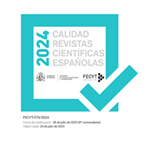A Pragmatic analysis of emotion-triggering strategies in TED talks
Resumen
Las charlas TED son un género relativamente nuevo en el que expertos en diferentes campos comparten sus conocimientos, ideas y experiencias con un público muy numeroso. Las charlas se retransmiten en todo el mundo, llegando así a espectadores internacionales en contextos interculturales. Aunque el lenguaje hablado en público se ha estudiado ampliamente, las charlas TED se consideran un género híbrido y presentan un nuevo campo de estudio. De este modo, aunque son similares en algunos aspectos, se diferencian en muchos aspectos de otros tipos de discurso oral, como pueden ser las clases magistrales, en la postura epistémica, la presentación de ideas o los marcadores macrodiscursivos utilizados (Caliendo y Compagnone, 2014). En el presente estudio partimos de la base de que el uso de la emoción sirve para provocar la respuesta de la audiencia, y nuestro objetivo es examinar la forma en que los hablantes usan las emociones para involucrar a los espectadores en sus monólogos, así como explorar otras estrategias usadas para generar respuesta del público, para identificar las que resultan más exitosas. El artículo analiza 120 charlas TED de dos campos diferentes, los negocios y la educación, tomando como punto de partida una lista básica de palabras relacionadas con las emociones, para continuar examinando cuál es la reacción del público ante estas palabras, observando la risa y el aplauso como las dos formas identificadas de respuesta. Los resultados indican que no existen diferencias significativas en los dos subcorpus analizados en cuanto a las palabras de emoción utilizadas, el uso de múltiples estrategias de humor y el hecho de tener en cuenta a las audiencias multiculturales por parte de los hablantes.
Descargas
Descarga artículo
Licencia
La revista Círculo de Lingüística Aplicada a la Comunicación, para fomentar el intercambio global del conocimiento, facilita el acceso sin restricciones a sus contenidos desde el momento de su publicación en la presente edición electrónica, y por eso es una revista de acceso abierto. Los originales publicados en esta revista son propiedad de la Universidad Complutense de Madrid y es obligatorio citar su procedencia en cualquier reproducción total o parcial. Todos los contenidos se distribuyen bajo una licencia de uso y distribución Creative Commons Reconocimiento 4.0 (CC BY 4.0). Esta circunstancia ha de hacerse constar expresamente de esta forma cuando sea necesario. Puede consultar la versión informativa y el texto legal de la licencia.











